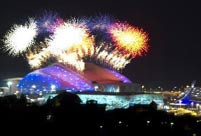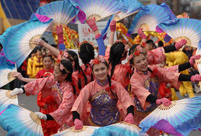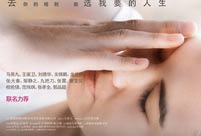 Turnip sculptures amaze tourists in Qingdao
Turnip sculptures amaze tourists in Qingdao Chinese ship formation conducts live fire training in West Pacific
Chinese ship formation conducts live fire training in West Pacific
 China comes in third at figure skating team event
China comes in third at figure skating team event
 China's teenager skater Yan shines at his Olympic debut
China's teenager skater Yan shines at his Olympic debut
 Taiwan-born actor stars on US TV series
Taiwan-born actor stars on US TV series
 Chinese Lunar New Year gift from abroad
Chinese Lunar New Year gift from abroad Chinese champions of Winter Olympic Games
Chinese champions of Winter Olympic Games  Zhang Yimou fined 7.48 mln for over-production
Zhang Yimou fined 7.48 mln for over-production
 Top 10 timeless female Chinese stars
Top 10 timeless female Chinese stars
XINING, Feb. 14 -- While China's city dwellers celebrated Valentine's Day and the traditional Lantern Festival, Tibetan monks celebrated their own holiday on Friday.
Forty-some Tibetan monk craftsmen with the Kumbum Monastery, a key monastery of the Gelukpa sect on the outskirts of Xining, capital of northwest China's Qinghai Province, carefully crafted a handmade butter sculpture in the temple's courtyard, a tradition dating back more than 400 years.
The sculptures made of white yak butter and mineral dyes depict scenes from the Buddha's teachings and show the sculptors' reverence for the Buddha and their wishes on the special day, said Losang Ngamsho, executive deputy chief of the temple's management committee.
Friday was the first full moon of the Year of the Horse in the Chinese lunar calendar, during which Han Chinese observed the Lantern Festival and ate sweet dumplings for good luck and reunion.
For Tibetans, an ethnic minority in China, the day marked the festival of Buddha Amitabha.
At dusk, local residents will swarm to the temple to worship the Buddha and enjoy the sculptures, one of Kumbum Monastery's three unique treasures, which also include fresco and embroidery.
"Lit up by rows of butter lamps, the sculptures are as vivid as life and sacred. They give visitors an impression of the Buddha's teachings about virtue and vice," said Zhao Zongfu, vice president of the China Folklore Society and an expert on plateau folklore.
For centuries, Tibetan monks have used the sculptures to express Buddhist beliefs, such as endurance and compassion, to inspire people to survive the harsh natural environment they live in and to always look for the good, he said.
When Tibet was a feudal society, clergy were the most educated people and monasteries played the leading role in preserving Tibetan culture.
Butter sculptures, together with prayer wheels, colorful prayer flags and piles of prayer stones, were endorsed by ancient Buddhist masters in Tibet as a flexible approach to help illiterate commoners practice Buddhism.
Chen Yongfa, a Tibetan from Rusar Township of Huangzhong County in Qinghai, comes to the Kumbum Monastery each winter to help local monk craftsmen prepare the annual butter sculpture show.
"The creation process is very moving. The sculptors keep challenging their limits and sacrifice their health," said the 40-year-old.
Since the butter melts at zero degrees, creators have to repeatedly cool their upper limbs by soaking their hands and arms in cold water mixed with ice blocks.
Many of the temple's senior sculptors have suffered finger distortions, periarthritis of the shoulders and rheumatism as they must work in a room with a temperature of minus 10 degrees Celsius, Losang Ngamsho said.
Yeba Gyatso, who joined the temple at the age of 13 to learn butter sculpture, said he might suffer similar pains in the future, but he believes in the power of faith.
"Each year, we strive to present our best work to the Buddha and Lama Tsongkhapa and wish for all in peace and happiness," said Yeba Gyatso, 43.
Tsongkhapa is the founder of the Gelukpa School of Tibetan Buddhism. The Kumbum Monastery was built on the birthplace of the master, who was born in 1357. The Dalai Lama and Panchen Lama are the high lamas of the Gelukpa school.
A growing number of people have come to visit the display since the temple's butter sculpture was listed as a national intangible cultural heritage in 2006.
Last year, the temple received nearly 200,000 visitors, including clergy, Buddhist followers and tourists from Sichuan, Gansu, Tibet and elsewhere.
Although it is rewarding to see the influx of visitors during the festival, Chen Yongfa said he always has mixed feeling during the creation process.
"It is inspiring and heart-wrenching. I really admire those sculptors who gritted their teeth to continue with the creation after catching a serious cold, as if they had muscles of iron," said Chen.
Losang Ngamsho said when the sculpting began, all participating sculptors made a vow with the Buddha in mind and would not quit easily.
However, producing the best work requires "more than solid faith," he said.
"Acute artistic vision and the will to bear hardships also matter," he added.
As sculptors are mainly trained by their masters through word of mouth and the process normally takes ten years, Losang Ngamsho said persuading younger monks to take up the craft has become a challenging task.
"They'd rather chant sutras and paint. That really worries me. I have to figure out a way to better preserve and pass down the skill," he said.
Currently, each participating sculptor receives a subsidy of 100 yuan a day for completing the annual task.
But sculptor Palden said that the biggest challenges they face are physical pains and exhaustion.
"Working long hours in an extremely cold environment is detrimental. One bad cold will cost several hundred yuan in medical bills," he said.
From 2006 to 2013, the Qinghai Provincial government earmarked 5.6 million yuan to support the training of butter sculptors. The province now has two state-level and five provincial-level butter sculpture masters.
Looking into the future, Zhao Zongfu suggested the government should help the temple establish better training and, if possible, a butter sculpture research institute to carry forward the Tibetan art form.
 Highlights of opening ceremony of Sochi 2014 Winter Olympic Games
Highlights of opening ceremony of Sochi 2014 Winter Olympic Games Highlights of Chinese New Year celebrations around the world
Highlights of Chinese New Year celebrations around the world  Chinese ship formation conducts live fire training in West Pacific
Chinese ship formation conducts live fire training in West Pacific Sanya bans skinny dipping in public beach
Sanya bans skinny dipping in public beach Top 20 most beautiful Chinese stars
Top 20 most beautiful Chinese stars  PLA navy conducts landing drills in South China Sea
PLA navy conducts landing drills in South China Sea  Snowscape in Chinese New Year
Snowscape in Chinese New Year Top 10 timeless female Chinese stars
Top 10 timeless female Chinese stars Top 10 Chinese films in 2013
Top 10 Chinese films in 2013 Ruins of Shang Dynasty's structure unearthed in Shaanxi
Ruins of Shang Dynasty's structure unearthed in Shaanxi  Intercity high speed train in operation for the first
Intercity high speed train in operation for the first  Severe coldness freezes large parts of China
Severe coldness freezes large parts of China  Beautiful moments of Sochi
Beautiful moments of Sochi  It's not just performing this year
It's not just performing this year Selfies of "Little colorful flag" girl unveiled
Selfies of "Little colorful flag" girl unveiled Day|Week|Month